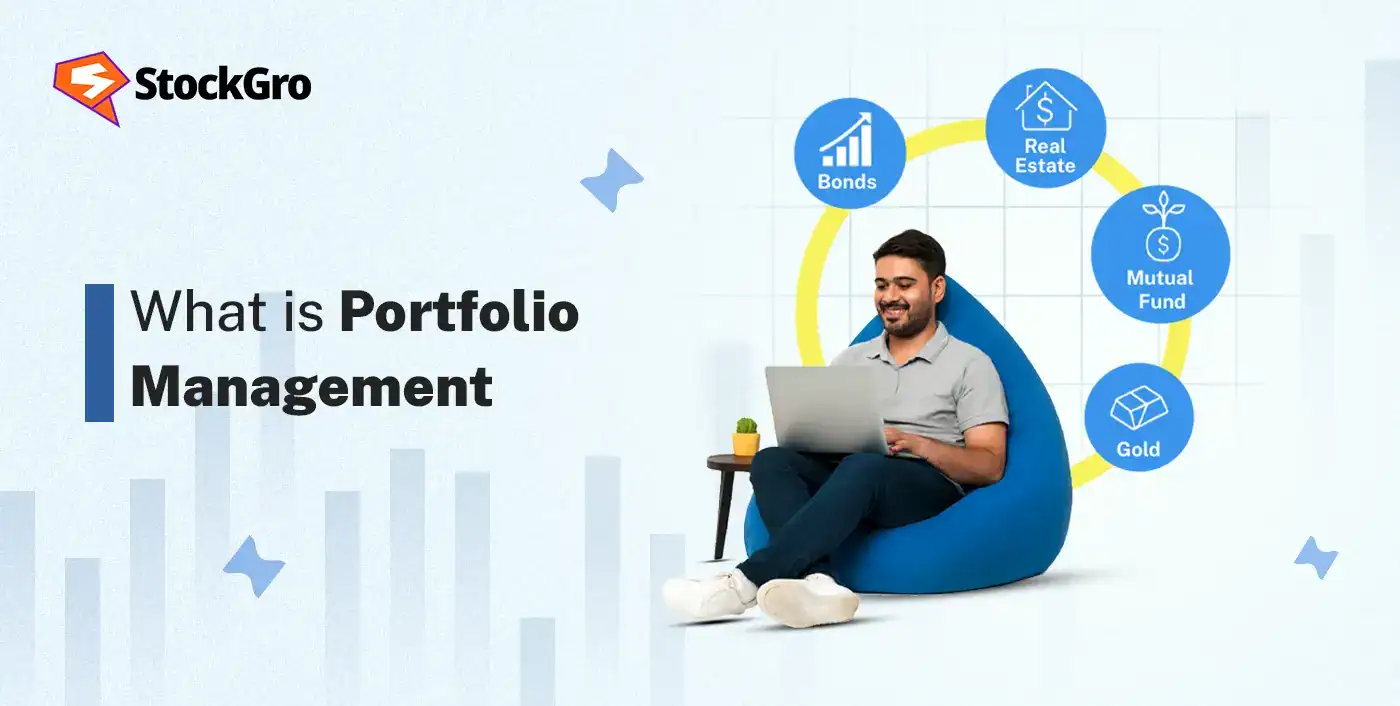
The rise of the Indian stock market has also resulted in a substantial increase of 58% in investors’ discretionary PMS(Portfolio Management Services) in India, rising from 1.22 lakhs in April 2023 to 1.92 lakhs in April 2025. The total AUM (Assets Under Management) has grown from ₹ 23.5 lakh crore to ₹ 32 lakh crore during the same period.
What is Portfolio Management?
Portfolio management involves selecting, managing and making changes to investments that align with the financial goals of an investor.
The Portfolio Managers should ensure the following:
- The portfolio manager must have a minimum net worth of over ₹ 5 crore.
- The minimum lump sum investment received from the client should not be less than Rs. 50 lakh.
Why Portfolio Management matters
Portfolio management is important for investors because of the following reasons:
- Capital Appreciation: Portfolio management helps in the growth of one’s investment over a period of time
- Risk Minimisation: Through diversification, the investments can be protected against market fluctuations
- Tax Savings: Special investment instruments such as ELSS(Equity Linked Savings Scheme) and Unit Linked Insurance Plan(ULIP) help in tax deductions
- Income Generation: Portfolio management helps the income-seeking investors to put their money in interest-bearing instruments such as FDs and bonds
- Capital Preservation: Efficient portfolio management also protects investments from inflation and market downturns.
Types of Portfolio Management
Portfolio management is divided into the following types based on the investment size, objectives, and style of management:
Active Portfolio Management:
In portfolio management, the manager is concerned with outperforming the market. A portfolio manager is constantly engaged to maximise profit by making decisions based on their research, forecasts, and market timing.
Passive Portfolio Management:
Passive portfolio management works to achieve similar or identical results to the market. There is a lower volume of trading as the manager is focused on matching the performance of a benchmark rather than beating it.
Discretionary Portfolio Management:
The portfolio manager is given full authority by the client to make decisions on their behalf and in their best interests under a discretionary style of portfolio management.
Non-discretionary Portfolio Management:
Under this style, the portfolio manager does not have the authority but acts only as an advisor to the client. It is fully up to the client to make a decision or not.
The Portfolio Management Process
Portfolio management is continuous in nature, and it follows a series of steps in the following manner:
- Setting Up Objectives: Firstly, the goal of investment is decided based on the investor’s expectations and risk appetite.
- Asset Allocation: Based on the client’s needs and market situation, the different asset classes in which investment is to be made are determined.
- Portfolio Construction: Out of the selected asset classes, specific instruments are identified that will make up the portfolio.
- Implementation: Actual money is put into the selected instruments, and the portfolio comes into existence.
- Monitoring and Reporting: The portfolio is evaluated against benchmarks, and the results are communicated to the clients.
- Rebalancing: The portfolio’s allocation is changed from time to time in order to keep it in line with the investment objectives as well as to adapt to any market conditions.
Key Principles: Asset Allocation, Diversification, Risk & Return
Some of the key principles that serve as the foundation for portfolio managers are:
Asset Allocation:
The portfolio consists of different asset classes, both volatile and non-volatile in nature, in order to maximise the return while minimising the risk. The allocation is dependent on the client’s risk tolerance and his investment goals.
Diversification:
Diversification makes sure that a portfolio is well-balanced in nature. By investing in different instruments, sectors, and geographies, the risk of underperformance by a single investment is heavily reduced.
Risk-Return:
Risk and return are two sides of the investment coin. Investors with higher potential returns also carry higher amounts of risk. It is the portfolio manager’s responsibility to strike a perfect balance between the two that best suits his clients.
Active vs Passive Strategies: Pros and Cons
An Active Strategy in portfolio management focuses on beating the market returns by the manager’s heavy participation and heavy trading volume based on their skill, experience, and expertise.
The pros of an active strategy are:
- Potential for higher returns
- Higher flexibility, can make adjustments for shifts in the market conditions.
- Tailor-made for each client’s particular requirements.
The cons of an active strategy are:
- High fees due to active participation of the portfolio manager.
- More time and commitment are required.
- Risk of underperformance by a specific investment
A Passive Strategy of portfolio management is concerned with generating returns similar to the market. The passive managers generally invest in index-based funds or ETFs as they want to replicate similar results.
The pros of an active strategy are:
- Lower fees as minimal trading and management involvement is required.
- More suitable for long-term investing and wealth creation
- Simple and easier to manage, even for the amateur
The cons of an active strategy are:
- Lesser flexibility as investments are tied to the market
- Full exposure to market falls and downturns.
Portfolio Rebalancing: What & Why
The term ‘portfolio rebalancing” is used to describe the act of reallocating the assets in a portfolio when it seems to stray away from the investment targets. Rebalancing keeps the portfolio in check, making sure it is progressing on the right path.
The major need for rebalancing arises from the market movements. Changes in the market may make the portfolio move away from its objectives, and the act of rebalancing helps with its realignment.
How to Choose the Right Strategy for You
The right strategy is the make or break element for any portfolio as different strategies are suited for different needs of investors. An investor should be wary of the following factors before making his own strategy:
1. Investment Objective: The investor puts in money into various goals such as down payments for a house, children’s education, and retirement. Before creating a portfolio, one must keep in mind whether they are looking to preserve their capital, appreciate it, or earn income from it.
2. Time-Horizon: Investors with a shorter time frame should invest in low-risk, highly liquid funds, and as the time horizon increases, the investors can look to invest in more risky avenues carrying higher growth potential.
3. Risk Tolerance: Based on their ability to face potential losses when aiming for higher returns, an investor is said to be aggressive. On the other hand, a conservative investor avoids risk and settles for a lower rate of return.
All these factors have to be kept in mind while making a strategy, and then a plan that satisfies all these parameters for the investor should be put into action.
Emerging Trends in Portfolio Management
Growing Incorporation of Artificial Intelligence(AI)
AI algorithms can be used for identifying market trends and uncovering hidden risks to optimize the portfolio in a better manner, but the involvement of the human element still remains essential. AI relies on data to produce results which can be biased or incomplete. Human judgment is still required to make the best out of them.
Quant-Based PMS
Quant-based portfolio management services are on the rise. Out of the PMS launched in the past year, Quant-based PMS makes five out of the top 10. This signals that more and more investors are seeking to maximise their returns not based only on the manager’s ability, but based on algorithms
Crypto As Part Of The Portfolio
Despite shakeouts and recent crashes, digital assets such as crypto have stayed in power. According to a survey by Ey-Parthenon, 64% investors hold digital assets in their portfolio and are looking to increase their capital investments in crypto in the coming years.
Out of these, 72% believe that digital assets are an important element of their wealth-building strategy.
Conclusion
Portfolio management is an important part of fulfilling the financial goals of an investor. The right style of portfolio management and strategy is dependent on the individual goals, risk tolerance, and time horizon available to an investor. The recent surge in AI tools and digital assets is helping investors make informed decisions and optimize their portfolios.
In a crux, efficient portfolio management is the key to the long-term financial success of an investor.
FAQs
In finance, portfolio management is used to describe the process of selecting and managing investments of an investor in order to meet their financial goals.
The different types of portfolio management are: active, passive, discretionary, and non-discretionary.
In active portfolio management, the manager tries to outperform the market by generating more returns. A passive portfolio management approach is focused on replicating the market by generating similar returns.
Portfolio rebalancing means making changes in the asset allocation structure of a portfolio . Fluctuations in the market may cause the current allocation to drift off from the investment goals, and thus, rebalancing helps it align with them.
Asset allocation is the backbone of any portfolio. Efficient allocation and regularly monitored changes are necessary for a successful portfolio and efficient portfolio management.
In discretionary portfolio management, the portfolio manager has the full authority to make decisions on behalf of their client.
The benefits of portfolio management include, but are not limited to: capital appreciation, risk mitigation, income generation, tax savings, and capital preservation.

